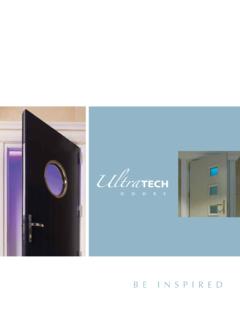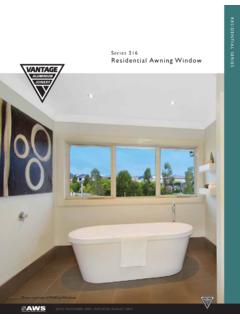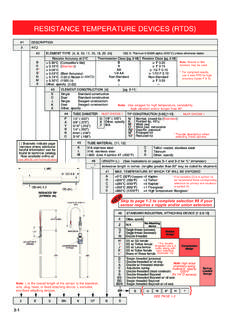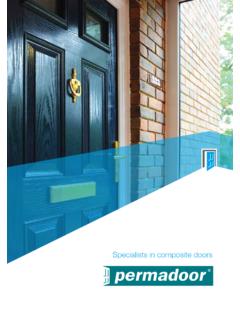Transcription of PFPF rules for metallic doorsets
1 PFPF and FTSG Agreed Assessment rules for: metallic doorsets PFPF and FTSG Agreed Assessment rules for: metallic doorsets Document dated 03 December 2004. Introduction The aim of the document is to give confidence to end-users that assessments which exist in the UK. market and have been produced by organisations that subscribe to this document, are of a satisfactory standard to be used in lieu of fire tests for building control and other purposes. Subscribing organisations are required to satisfy the corporate requirements of this document to employ individuals that subscribe to professional principles and to have a nationally recognised quality system accredited to EN ISO 9000 or EN 45000.
2 The document includes and extends upon the principles and procedures embodied in FTSG. Resolution 82: 2001 and its predecessors Resolution 64 and 64a: 1993. These resolutions which have been widely circulated to regulatory authorities, consultants and manufacturers for many years are added to by this document. This document relates to the production of assessments which are offered in the absence of specific fire resistance test results. The PFPF and UK Fire Test Study Group (FTSG) an association of the major fire testing laboratories in the UK and the relevant UK Trade Associations have produced this document In all cases, the resulting assessment will be carried out in accordance with the PFPF guide to undertaking assessments in lieu of fire tests and applies to tests conducted in accordance with BS.
3 476: Part 22 or EN 1634-1. Note to users Where it is been possible, to identify specific parameter failures, the assessment for all other construction parameter variations can be based on the performance achieved after isolating the premature failure(s). PFPF rules for steel doorsets Page 2 of 9. 01 December 2006. Contents INTRODUCTION 2. DOOR LEAF SIZE FOR metallic doorsets : 4. GLAZING SYSTEM/APERTURES FOR metallic doorsets : 5. SUPPORTING CONSTRUCTIONS FOR metallic doorsets 8. DOOR FRAMES FOR metallic doorsets 8. SMALL SCALE TESTING FOR metallic doorsets 9.
4 PFPF rules for steel doorsets Page 3 of 9. 01 December 2006. Definitions: High, Medium & Low distortion . - low <40% of effective rebate depth - medium >40% and <85% of effective rebate depth - high >85% of effective rebate depth Where more than one test report is provided, the average of the maximum distortion values of all reports shall be used. The measurements shall be taken from the start of the test at any time during the complete required classification period, including any required overrun period required to achieve Category B (Note: measuring positions are given in EN 1634-1 but it is intended that these will be clarified further by FTSG/EGOLF).
5 The values shall be the maximum movement measured at any position at the edges of the door leaf/ves. Glazing system . A complete system including any lining, beads, bead fixings, glass and glazing gasket. The edge cover, expansion allowance etc shall be maintained in all cases. Door leaf size Rule SD1. Height possible to increase the leaf size in line with direct application or possible to a maximum addition equal to the tested dimension between the latch and top of the door and providing an additional top hinge/dog bolt together with additional latch in the area of the top free corner are incorporated or possible for doorsets which have achieved category B up to.
6 - 15% for high distortion - 20% for medium distortion and 25% for low distortion, providing overlap of door to frame jamb is not reduced and additionally (for EW) a thermal emission calculation within the 15 KW limit For doorsets which do not achieve Category B it is possible to increase the size of leaves in accordance with the following calculation: Actual overrun from test X % increase indicated above Required minutes to achieve Category B. Example: 120 minute door achieves 128 minutes and is medium distortion, therefore 8 mins (actual overrun).
7 X 20% (medium distortion). 12 minutes (overrun for Cat B). = 15% increase in height For doorsets where no distortion measurements are available, the distortion of the leaves shall be assumed to be high distortion PFPF rules for steel doorsets Page 4 of 9. 01 December 2006. Rule SD2. Width possible to increase the leaf size in line with direct application or possible for doorsets which have achieved category B up to: - 15% for high distortion - 20% for medium distortion and - 25% for low distortion, providing overlap of door to frame jamb is not reduced and additionally (for EW) a thermal emission calculation within the 15 KW limit For doorsets which do not achieve Category B it is possible to increase the size of leaves in accordance with the calculation given in rules SD1.
8 For doorsets where no distortion measurements are available, the distortion of the leaves shall be assumed to be high distortion Rule SD3. Area - possible to increase the leaf size in line with direct application or possible for doorsets which have achieved category B up to: - 20% for high distortion - 25% for medium distortion and - 30% for low distortion, providing overlap of door to frame jamb is not reduced and additionally (for EW) a thermal emission calculation within the 15 KW limit For doorsets which do not achieve Category B it is possible to increase the size of leaves in accordance with the calculation given in rules SD1.
9 For doorsets where no distortion measurements are available, the distortion of the leaves shall be assumed to be high distortion Rule SD4. For doorsets that achieved a classification in excess of that required, the allowable size increases given above may be increased by an additional 5% of tested door leaf size per 30 minutes of classification period overrun up to a maximum of an additional 15%. However for double-leaf doorsets , an astragal shall always be used regardless if it was tested with such a component or not.
10 Glazing System/Apertures Rule SD5. The type of glazing system including type and number of fixings per meter of perimeter, shall not be changed from those tested unless appropriately covered by test evidence in a similar type doorset, acceptable test evidence is outlined in SD6 or unless tested glazing systems have achieved Category B. In this case, it is possible to change beads providing the material, fixing, edge retention of the glass, glass edge cover and clearance are maintained. Rule SD6. A glazing system previously tested in a steel door leaf of similar construction (particularly the core material), may be assessed in another steel based door leaf assuming the door leaf into which it is proposed to be fitted has previously been tested having incorporated an aperture of the proposed dimensions (height/width and area).






